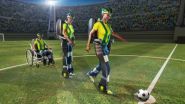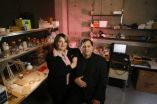(Press-News.org) This news release is available in German.
According to researchers in the Walk Again Project, all systems are go for a bold demonstration of neuroscience and cognitive technology in action: On June 12, during the opening of the FIFA 2014 World Cup in Brazil, a paralyzed person wearing a brain-controlled robotic exoskeleton is expected to make the first kick of the football championship.
The Walk Again Project is an international collaboration of more than one hundred scientists, led by Prof. Miguel Nicolelis of Duke University and the International Institute for Neurosciences of Natal, Brazil. Prof. Gordon Cheng, head of the Institute for Cognitive Systems at the Technische Universitaet Muenchen (TUM), is a leading partner.
Eight Brazilian patients, men and women between 20 and 40 years of age who are paralyzed from the waist down, have been training for months to use the exoskeleton. The system works by recording electrical activity in the patient's brain, recognizing his or her intention – such as to take a step or kick a ball – and translating that to action. It also gives the patient tactile feedback using sensitive artificial skin created by Cheng's institute.
The feeling of touching the ground
Inspiration for this so-called CellulARSkin technology – as well as for the Walk Again Project itself – came from a 2008 collaboration. As Cheng sums up that complex and widely reported experiment, "Miguel set up a monkey walking on a treadmill in North Carolina, and then I made my humanoid robot walk with the signal in Kyoto." It was a short step for the researchers to envision a paralyzed person walking with the help of a robotic exoskeleton that could be guided by mental activity alone.
"Our brains are very adaptive in the way that we can extend our embodiment to use tools," Cheng says, "as in driving a car or eating with chopsticks. After the Kyoto experiment, we felt certain that the brain could also liberate a paralyzed person to walk using an external body." It was clear that technical advances would be required to allow a relatively compact, lightweight exoskeleton to be assembled, and that visual feedback would not be enough. A sense of touch would be essential for the patient's emotional comfort as well as control over the exoskeleton. Thus the challenge was to give a paralyzed person, together with the ability to walk, the feeling of touching the ground.
A versatile solution
Upon joining TUM in 2010, Cheng made it a research priority for his institute to improve on the state of the art in tactile sensing for robotic systems. The result, CellulARSkin, provides a framework for a robust and self-organizing surface sensor network. It can be implemented using standard off-the-shelf hardware and thus will benefit from future improvements in miniaturization, performance, and cost.
The basic unit is a flat, six-sided package of electronic components including a low-power-consumption microprocessor as well as sensors that detect pre-touch proximity, pressure, vibration, temperature, and even movement in three-dimensional space. Any number of these individual "cells" can be networked together in a honeycomb pattern, protected in the current prototype by a rubbery skin of molded elastomer.
"It's not just the sensor that's important," Cheng says. "The intelligence of the sensor is even more important." Cooperation among the networked cells, and between the network and a central system, allows CellulARSkin to configure itself for each specific application and to recover automatically from certain kinds of damage. These capabilities offer advantages in enabling smarter, safer interaction of machines with people, and in rapid setup of industrial robots – as is being pursued in the EU-sponsored project "Factory in a Day."
In the Walk Again Project, CellulARSkin is being used in two ways. Integrated with the exoskeleton, for example on the bottoms of the feet, the artificial skin sends signals to tiny motors that vibrate against the patient's arms. Through training with this kind of indirect sensory feedback, a patient can learn to incorporate the robotic legs and feet into his or her own body schema. CellulARSkin is also being wrapped around parts of the patient's own body to help the medical team monitor for any signs of distress or discomfort.
A milestone, but "just the beginning"
"I think some people see the World Cup opening as the end," Cheng says, "but it's really just the beginning. This may be a major milestone, but we have a lot more work to do." He views the event as a public demonstration of what science can do for people. "Also, I see it as a great tribute to all the patients' hard work and their bravery!"
INFORMATION:
This research has been supported in part by the German Research Foundation (DFG) and the European Union.
Contact:
Prof. Gordon Cheng
Institute for Cognitive Systems
Technische Universitaet Muenchen
Tel: +49 89 289 26800
gordon@tum.de
Further information:
http://www.ics.ei.tum.de
https://www.youtube.com/user/icsTUMunich
http://www.cellularskin.eu
http://www.factory-in-a-day.eu
Technische Universitaet Muenchen (TUM), founded in 1868, is one of Europe's leading international research universities, with around 500 professors, 10,000 academic and non-academic staff, and 36,000 students. Its focus areas are the engineering sciences, natural sciences, life sciences and medicine, reinforced by schools of management and education. TUM acts as an entrepreneurial university that promotes talents and creates value for society. In that it benefits from having strong partners in science and industry. It is represented worldwide with a campus in Singapore as well as offices in Beijing, Brussels, Cairo, Mumbai, and Sao Paulo. A large number of Nobel Prize winners and inventors such as Rudolf Moessbauer, Rudolf Diesel and Carl von Linde have done research at TUM. In 2006 and 2012 it won special recognition as a German "Excellence University." In international rankings, it regularly places at the top among the universities in Germany. http://www.tum.de
'All systems go' for a paralyzed person to kick off the World Cup
TUM technology endows brain-controlled exoskeleton with sense of touch
2014-06-10
ELSE PRESS RELEASES FROM THIS DATE:
Snowballs to soot: The clumping density of many things seems to be a standard
2014-06-10
Particles of soot floating through the air and comets hurtling through space have at least one thing in common: 0.36. That, reports a research group at the National Institute of Standards and Technology (NIST), is the measure of how dense they will get under normal conditions, and it's a value that seems to be constant for similar aggregates across an impressively wide size range from nanometers to tens of meters.*
NIST hopes the results will help in the development of future measurement standards to aid climate researchers and others who need to measure and understand ...
Charging portable electronics in 10 minutes
2014-06-10
RIVERSIDE, Calif. (http://www.ucr.edu) — Researchers at the University of California, Riverside Bourns College of Engineering have developed a three-dimensional, silicon-decorated, cone-shaped carbon-nanotube cluster architecture for lithium ion battery anodes that could enable charging of portable electronics in 10 minutes, instead of hours.
Lithium ion batteries are the rechargeable battery of choice for portable electronic devices and electric vehicles. But, they present problems. Batteries in electric vehicles are responsible for a significant portion of the vehicle ...
New study shows that oatmeal can help you feel full longer
2014-06-10
Chicago, IL, June 10, 2014: New research published in the Nutrition Journal reveals that calorie-for-calorie, even a serving of instant oatmeal is more filling than a ready-to-eat (RTE), oat-based cereal. Researchers found that eating a bowl of instant oatmeal for breakfast is more satiating and helps to manage hunger better than the same amount of calories from a leading oat-based, cold cereal, even when consumed in smaller portions than previously found.
Frank Greenway, M.D. and colleagues at the Pennington Biomedical Research Center at Louisiana State University ...
Limiting carbs could reduce breast cancer recurrence in women with positive IGF1 receptor
2014-06-10
Lebanon, NH (June 10, 2014) - Dartmouth researchers have found that reducing carbohydrate intake could reduce the risk of breast cancer recurrence among women whose tumor tissue is positive for the IGF-1 receptor. The study, "Risk of Breast Cancer Recurrence Associated with Carbohydrate Intake and Tissue Expression of IGFI Receptor," will appear in the July issue of Cancer Epidemiology Biomarkers & Prevention.
"There is a growing body of research demonstrating associations between obesity, diabetes, and cancer risk," said lead author Jennifer A. Emond, an instructor in ...
Syracuse University geologists confirm oxygen levels of ancient oceans
2014-06-10
Geologists in the College of Arts and Sciences have discovered a new way to study oxygen levels in the Earth's oldest oceans.
Zunli Lu and Xiaoli Zhou, an assistant professor and Ph.D. student, respectively, in the Department of Earth Sciences, are part of an international team of researchers whose findings have been published by the journal Geology (Geological Society of America, 2014). Their research approach may have important implications for the study of marine ecology and global warming.
"More than 2.5 billion years ago, there was little to no oxygen in the oceans, ...
Lead abatement a wise economic, public health investment
2014-06-10
ANN ARBOR–Childhood lead exposure costs Michigan residents an estimated $330 million annually, and a statewide remediation program to eliminate the source of most lead poisoning would pay for itself in three years, according to a new report.
"Economic Impacts of Lead Exposure and Remediation in Michigan," compares the cost of four well-documented impacts of lead exposure--increased health care, increased crime, increase in special education, and decline in lifetime earnings--with the cost of lead abatement of high-risk homes.
The report is a collaboration between the ...
The whole truth
2014-06-10
CAMBRIDGE, MA -- Children learn a great deal about the world from their own exploration, but they also rely on what adults tell them. Studies have shown that children can figure out when someone is lying to them, but cognitive scientists from MIT recently tackled a subtler question: Can children tell when adults are telling them the truth, but not the whole truth?
Led by Laura Schulz, the Class of 1943 Career Development Associate Professor of Cognitive Science, the researchers found that not only can children make this distinction, but they can also compensate for incomplete ...
Wolves in wolves' clothing not all the same
2014-06-10
New research co-authored by University of Calgary alumna Erin Navid provides evidence that British Columbia's mainland wolves and coastal wolves are more distinct than previously believed.
The research, published today in the scientific journal BMC Ecology, affirms what Chester Starr, an elder from the Heiltsuk First Nation on BC's remote west coast, and his people have always known: 'Timber Wolves' occupy the mainland of the British Columbia coast and 'Coastal Wolves' live on the nearby islands. Starr's insight provided motivation for the study.
"What makes this study ...
Coho salmon: Pinks' and chums' eating cousin
2014-06-10
Newly published research co-authored by scientists at Simon Fraser University and the Raincoast Conservation Foundation shows juvenile coho salmon benefit from dining on the distant remains of their spawning pink and chum cousins.
While juvenile coho salmon feed directly on spawning pink and chum salmon carcasses and eggs, even coho with no direct contact with spawning pink and chum benefit from their nutrient contributions to stream ecosystems.
The new research shows that juvenile coho abundance is up to three times higher in streams with abundant pink and chum compared ...
Genetics reveal that reef corals and their algae live together but evolve independently
2014-06-10
New research reveals that Caribbean corals and the algae that inhabit them form a remarkably stable relationship -- new knowledge that can serve as an important tool in preserving and restoring vital reef-building corals. A scientific paper describing these new findings by a team of marine biologists at Penn State University will be published as a cover article in Molecular Ecology on 10 June 2014.
Coral reefs are important for protecting shorelines, providing seafood, and generating millions of dollars in recreation revenue each year, but rising water temperatures due ...
LAST 30 PRESS RELEASES:
Study debunks myth of native Hawaiians causing bird extinctions
Tailored biochar could transform how crops grow, resist disease, and clean polluted soils
Biochar-based enzyme technology offers new path for cleaner water and soil
Biochar helps farmland soils withstand extreme rain and drought by steadying carbon loss
New study reveals major gaps in global forest maps
Ochsner Health names Dr. Timothy Riddell executive vice president and chief operating officer
Can future-focused thoughts help smokers quit?
From brain scans to alloys: Teaching AI to make sense of complex research data
Stem Cell Reports seeks early career editors to join the editorial board
Signs of ancient life turn up in an unexpected place
Pennington Biomedical researchers explore factors behind body’s ability to regulate weight
Zhongping Lee awarded the Nils Gunnar Jerlov Medal
Deborah S. Kelley awarded the Wallace S. Broecker Medal
Novel immunotherapy demonstrates early potential to overcome resistance to immune checkpoint therapy
LLM treatment advice agrees with physician recommendations in early-stage HCC, but falls short in late stage
Deep learning model trained with stage II colorectal cancer whole slide images identifies features associated with risk of recurrence – with higher success rate than clinical prognostic parameters
Aboard the International Space Station, viruses and bacteria show atypical interplay
Therapies that target specific type of cell death may be an effective avenue for cancer treatment, UTHealth Houston researchers find
CHEST releases guideline on biologic management in severe asthma
Scientists create a system for tracking underwater blackouts
Fruit fly pigmentation guides discovery of genes that control brain dopamine and sleep
World's largest physics conference to be held in Denver and online this March
New mega-analysis reveals why memory declines with age
Understanding ammonia energy’s tradeoffs around the world
UTHealth Houston researchers map gene disruptions in sporadic early onset Alzheimer’s disease across key brain regions
Minimum wage increases are linked to safer pregnancies
Left in the cold: Study finds most renters shut out of energy-saving upgrades
This crystal sings back: Illinois collaboration sheds light on magnetochiral instability
Organisms in the Atacama Desert soil are remarkably diverse
Children’s Hospital Colorado research outlines first pediatric classifications for suicide risk in adolescents and kids
[Press-News.org] 'All systems go' for a paralyzed person to kick off the World CupTUM technology endows brain-controlled exoskeleton with sense of touch







